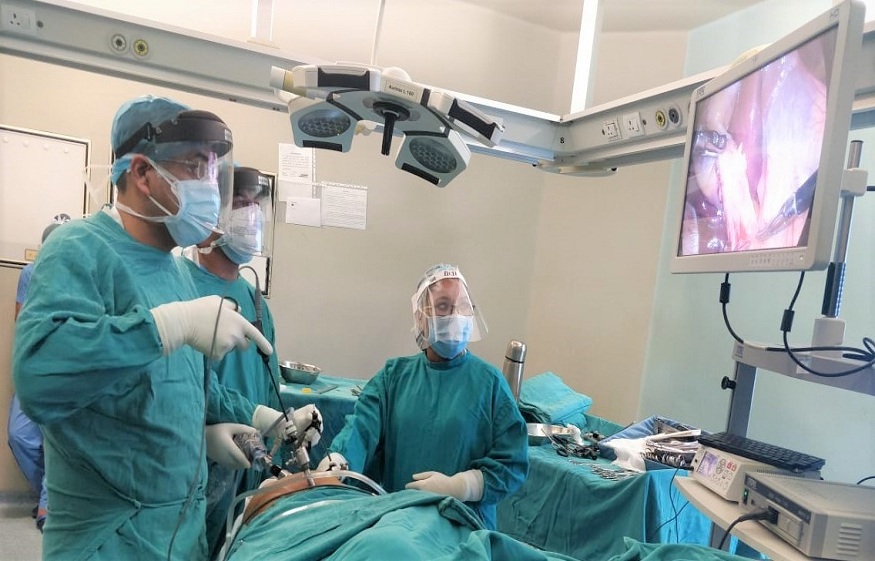WHAT ARE HEMORRHOIDS?
Haemorrhoids (commonly known as piles) are small varicose veins in the anal canal. They occur when the veins located in the anus area dilate excessively.
Anyone can have haemorrhoids and not have any symptoms, so the mere fact of noticing haemorrhoids should not be considered a disease. However, when they cause discomfort, we speak of pathological haemorrhoids and require medical evaluation.
TYPES OF HEMORRHOIDS
We usually talk about two types of haemorrhoids according to their location concerning the anus:
Internal haemorrhoids: the affected veins are located in the inner area of the anus and are covered by rectal mucosa.
External haemorrhoids: they are located in the outermost part of the anus and are protected by the anal epithelium.
GRADES OF HEMORRHOIDS
The severity of haemorrhoids is classified according to their degree of prolapse:
Grade I: They do not prolapse during defecation. They are purely internal, and in case of giving symptoms, it is usually in the form of bleeding.
Grade II: They prolapse during defecation but return spontaneously into the anus at the end.
Grade III: they prolapse and do not return unless manually reintroduced by the patient.
Grade IV: The prolapse is permanent. The patient reports always taking them outside.
CAUSES OF HEMORRHOIDS
Any increase in venous pressure in the anorectal area sustained over time favours the appearance of haemorrhoids:
Constipation is one of the leading causes for having haemorrhoids. The increased time spent sitting on the toilet and the physical effort to expel hard stools favour anal venous congestion and prolapse of haemorrhoids. Standing statically for a long time increases anal venous pressure.
During pregnancy and childbirth, the risk of haemorrhoids increases significantly due to the increase in abdominal pressure and the physical effort of delivery.
The increase in abdominal fat in obesity, like pregnancy, favours venous stasis by increasing pressure in the iliac and hemorrhoidal veins.
There is also a genetic predisposition. If there is a family history (parents or grandparents who suffered from haemorrhoids), there is a greater risk of suffering.
A diet low in fibre favours constipation and is another factor favouring haemorrhoids.
SYMPTOMS OF HEMORRHOIDS
Grade I-II haemorrhoids are usually asymptomatic. The main symptoms that accompany pathological haemorrhoids are:
Bleeding – usually occurs when passing stool or wiping with toilet paper. It is generally rare and is detected by traces of bright red blood in the cup or stains on the toilet paper.
Prolapse: consists of the exteriorisation of haemorrhoids through the anus. There are four degrees, as we have explained before.
Pain: haemorrhoids do not usually hurt unless they become congested and thrombosed. When the onset of pain is sudden and lasts for days, we may face thrombosis of the haemorrhoids. A lump is usually noticed in the anal region that is very sensitive to friction. It occurs when there is venous congestion for a long time.
Secretion: it is more frequent in grade IV haemorrhoids as the hemorrhoidal mucosa is continuously exposed. It may cause skin irritation and cause itching (itching) or a burning sensation, especially during bowel movements.
DIAGNOSIS OF HEMORRHOIDS
The patient’s symptoms and physical examination are usually sufficient to diagnose pathologic haemorrhoids. However, sometimes a complementary study must be done to confirm the presence of haemorrhoids and rule out other pathologies that also cause rectal bleeding.
The visual and manual examination of the doctor will establish the presence of haemorrhoids and what type they are. The prolapsed external or internal ones will be visualised with the naked eye and can be categorised according to the possibility of reintroduction that they present. The presence of an extremely painful purple lump will be highly suggestive of thrombosis.
Anoscopy: consists of exploration with the help of an anoscope of the lower rectum. It is a simple examination that can help diagnose internal haemorrhoids.
Retinoscopy: it is indicated in young patients with a history of rectal bleeding in whom haemorrhoids are not visible and internal haemorrhoids are suspected. It is an endoscopic procedure of the anal canal and rectum only.
Colonoscopy: In patients >40 years of age in whom the main symptom is bleeding when defecating, doubts may arise, despite the presence of haemorrhoids, with other more severe diagnoses. For this reason, a complete colonoscopy is usually performed to rule out tumours, diverticula or polyps as the cause of this bleeding.
TREATMENT OF HEMORRHOIDS
Surgery is the TREATMENT of choice in patients with primary hyperparathyroidism, with a cure rate of between 95 and 98% of cases in the first intervention performed by an expert surgeon. with less postoperative pain and earlier incorporation into your daily life.Multiple treatments for haemorrhoids have been described. The most accepted treatments in the scientific literature are described below according to the severity of the haemorrhoids:
Grade I haemorrhoids:
Hygienic-dietary measures:
- Diet rich in fibre and fluids.
- Use hygienic wipes instead of toilet paper, which moisturise, relieve itching and prevent possible infections.
- laxatives
Medication:
- Analgesics and muscle relaxants to eliminate pain and reduce anal hypertonia if it exists.
- Antihemorrhoidal cream. They usually contain a local anaesthetic and temporarily minimise discomfort.
Grade II haemorrhoids:
Hygienic-dietary measures + medication.
Internal hemorrhoidal ligation with an elastic band: it consists of placing a circular elastic band on an internal haemorrhoid. Haemorrhoid tends to dry up and fall off in a few days. It is an outpatient treatment.
Grade III-IV haemorrhoids:
Hygienic-dietary measures + medication +/- elastic ligation.
Surgical treatment: grades III-IV do not usually improve significantly with conservative measures, and some surgical procedure is typically necessary.
There are different surgical techniques (laser, infrared, sclerotherapy, etc.), but the method showing the best long-term results is the excision of the pathological haemorrhoidal bundles. Today it is the most widespread and preferred treatment.
With the appearance of new energy devices, it has been possible to significantly reduce postoperative pain and the risk of bleeding after this surgery. Specifically, several studies have shown how the ultrasonic scalpel and the Ligasure significantly reduce postoperative pain with excellent long-term results.



